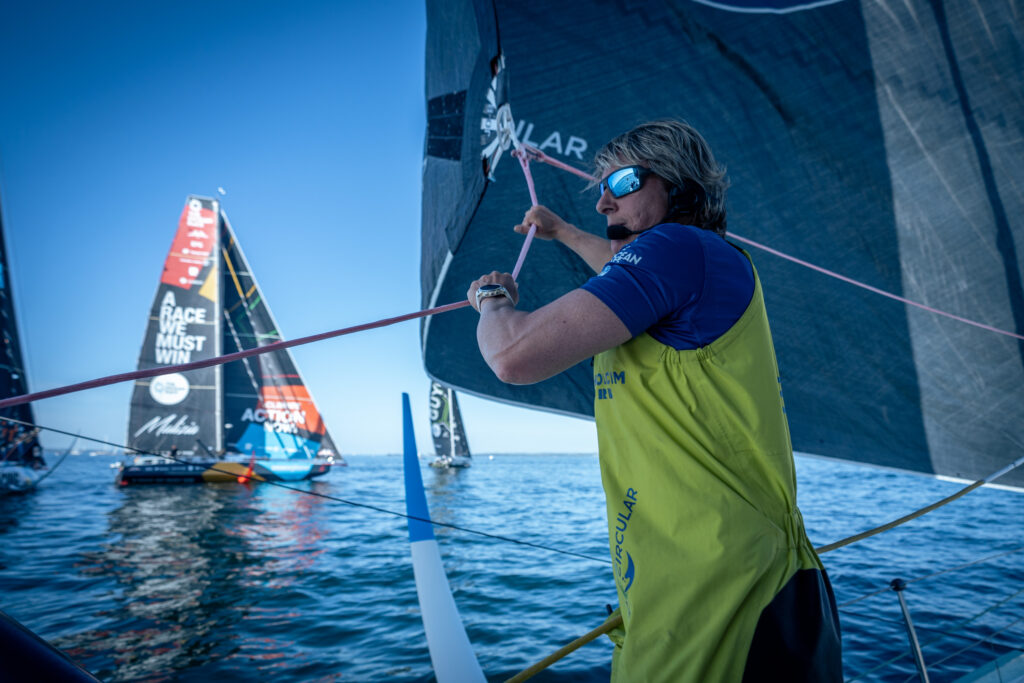Record number of female sailors take part in The Ocean Race 2022-23
 © Anne Beauge / Biotherm / The Ocean Race The Ocean Race 2022-23 – 25 April 2023, Leg 4 onboard Biotherm. Girls ‘ watch Mariana Lobato and Marie Riou during reefing down the main.
© Anne Beauge / Biotherm / The Ocean Race The Ocean Race 2022-23 – 25 April 2023, Leg 4 onboard Biotherm. Girls ‘ watch Mariana Lobato and Marie Riou during reefing down the main.
The Ocean Race 2022-23 featured more female sailors than in any of the previous events in the race’s 50-year history, organisers have confirmed.
The round-the-world race concluded in late June, with the 11th Hour Racing Team winning the overall race following a jury hearing. The team had been forced to retire after a no-fault collision, but were later awarded four points of redress to bring them to first place on the leaderboard.
Overall, across the five IMOCAs taking part in the race and the six VO65s taking part in the Ocean Race Sprint, there were 39 female sailors, making up 28 per cent of the competitors overall and 98 male sailors, making up 72 per cent.
This is a third more than the previous edition and continues the upward trend of more women sailing in the race. In 2014-15, 18 per cent of competitors were female, while in the last edition (2017-18), the figure rose to 21 per cent.

Organisers have confirmed they’re aiming for a 50:50 split of women and men by 2030.
For the 2017-18 edition, the race introduced a rule requiring all teams to include at least one woman. While each IMOCA is required to have at least one female competitor onboard the four-strong sailing team, and three of the ten sailors onboard VO65s are required to be female, Biotherm exceeded the quota, with two men and two women sailing in three of the seven legs.
The French IMOCA team also had a female onboard reporter (OBR) for several legs, as did Team Holcim – PRB, while Viva México had a female onboard reporter on all their legs and Mirpuri/Trifork Racing Team for leg 2. The race featured only one female OBR in the last edition and two in 2014-15.
Following a big push to bring gender balance to the race official roles, the current edition had an international jury of 11 members, composed of six women and five men. This figure is significantly higher than elsewhere in the industry, with certified international sailing judges only consisting of around 15 per cent women.

“Making sailing more inclusive is one of the most important things we can do to secure the future of the sport,” says Richard Brisius, race chair of the Ocean Race. “We’re delighted to have a record percentage of female competitors in the race and more females taking on traditionally male-dominated roles. We are sailing in the right direction, but more needs to be done to break down barriers and create pathways into the sport for women. Just as we have set an industry benchmark in driving more female participants in the sport, we need to move the dial on diversity and leave a legacy in which the sport becomes much more accessible to all.
“Coming together as an industry and working collaboratively is the only way that this can be achieved. For the race, we will continue to work with our host cities and local and national sailing federations to create pathways and opportunities. We also need greater commitments and action across the industry.”
Abby Ehler is a Holcim – PRB sailor and co-founder of the UK-based sailing inclusivity charity Magenta Project. “I have participated in four editions of this race and the Ocean Race 2022-23 has taken a step forward in terms of inclusivity,” says Ehler. “I have genuinely felt part of a team, and not a token gesture to a rule. This, in my mind, says a lot and shows that change is happening. Men and women competing side by side in a team is now being normalised – we are one of many, rather than the first, or the only.
“I do believe that the rules around crew diversity help to increase female participation and inclusion and I hope this continues with the pathways and opportunities ensuring that crew diversity occurs organically without the need for a rule.”

During this edition, the Ocean Race teamed up with logistics partner GAC Pindar, The Magenta Project and World Sailing Trust to host a series of panel discussions and networking events aimed at driving greater diversity and equality in sailing.
The Ocean Race was the first round-the-world crewed race with female sailors, with 13 women competing in the first edition in 1973.










